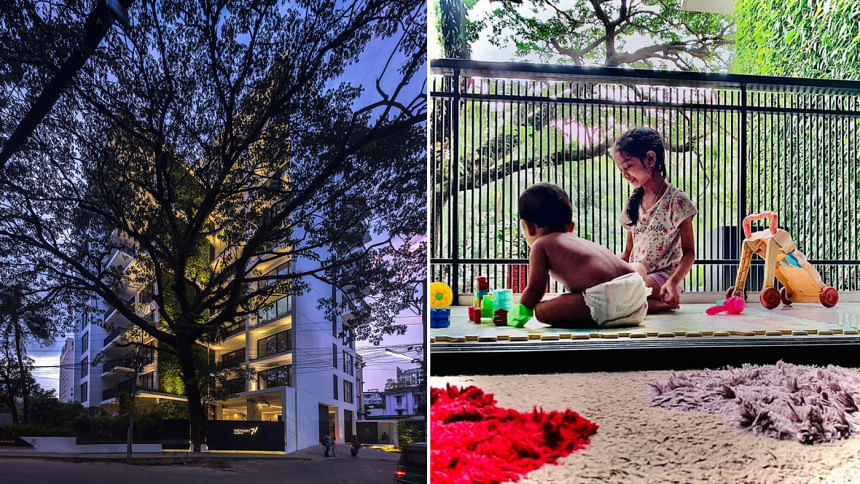From Concrete Jungle to Urban Oasis: Combating Heat Islands with Green Plot Ratio

Imagine a city where greenery isn't a luxury—it's woven into the fabric of daily life. Where concrete walls are cloaked in foliage, skyscrapers are adorned with vertical gardens, and rooftops transform into lush, elevated landscapes. This isn't a distant dream. It's the future of sustainable architecture, and the future must begin now.
Over the past decade, the world has been heating up at an alarming pace. I still recall my childhood winters, when I'd need sweaters from late October to early March. Out of curiosity, I once asked my father, "Was the world colder back then?"
With calm certainty, he replied, "Much cooler."
Later, I researched and found that global temperatures had risen by just over one degree Celsius in the past 50 years. One degree—yet it has made a world of difference. That seemingly small rise has triggered extreme weather events, melting ice caps, and a global sustainability crisis.
Urbanization is a major contributor to this trend. Cities, though covering only 3% of the Earth's land surface, consume a staggering 75% of the world's energy. In Bangladesh, about 7.5% of our land is urbanized, but it accounts for nearly 70% of national energy consumption—most of it fossil fuel-based. This energy use releases greenhouse gases, which intensify the urban heat island effect—raising temperatures in our cities, worsening air quality, and increasing flood risks.
Dhaka, Chattogram, Khulna, Sylhet, Narayanganj—these cities are growing fast. And with them, real estate and construction sectors are expanding rapidly. But this growth must come with accountability. Developers have a moral and ecological responsibility to minimize the heat impact of built environments.
One innovative tool that can guide us in this journey is the Green Plot Ratio (GPR)—a simple yet powerful urban planning metric.
What is Green Plot Ratio (GPR)?
The Green Plot Ratio quantifies the proportion of green areas—trees, shrubs, lawns, rooftop gardens, vertical greenery—compared to the total plot area. It's a straightforward way to assess the ecological value of a development.

Green elements that count toward GPR include: Ground-level soft landscaping (lawns, flower beds, trees), Rooftop gardens or green roofs, Vertical greenery (green façades or living walls), Sky gardens or planted terraces, Greenery on balconies.
But not all greenery is equal. This is where Weighted GPR comes into play. Each green component is assigned a weight based on its environmental impact.
Example:
On a 10,000 sft plot: if we have 3,000 sft grass (weight 1), 1,000 sft shrubs (weight 2) & 500 sft trees (weight 3)

Trees, for instance, offer superior shading, carbon sequestration, and biodiversity support compared to grass or shrubs. This kind of weighted matrix allows for more informed and effective green planning.
From Vision to Reality
We began applying the GPR concept back in 2018. The first milestone was a project called Memory 71, where we aimed for a 100% Green Plot Ratio. One evening, I sat down with our Chief Architect, Wahidur Rahman Adib, over dinner. We discussed creating a benchmark project—one that truly respected the GPR framework.
We've long admired sustainable architecture, particularly a project called Tree House in Singapore, which holds the Guinness World Record for the world's largest vertical garden. It inspired us to think big.
With guidance from Arch. Adib and the talented team at Inspace Architects, we conceptualized a building with a 95-foot vertical green façade—the longest in the city at that time. We planted trees on terraces, retained a 55-year-old canopy tree to preserve shade and reduce ambient temperature, and incorporated a wide variety of shrubs and Rangoon Bambusa along the boundary. We even added a sky garden at the rooftop.
The land area of Memory 71 was 7,200 square feet—and we matched that with 7,200 square feet of green coverage. A perfect 100% GPR.
Since then, we've integrated GPR principles into many of our developments-White Oak at Mehedibag: 80% GPR, Park Terrace: 138% GPR, Novera: 100% GPR, Park windsor: 78%, Queens Park 70%, Greenwood 70% GPR, Rosewood 70% GPR, Z70 70% GPR and Casa Crown, Hillcrest, CK Tower—all carry significant green ratios & it inspired the city dwellers & also the developers.
The Urgency of Now
Climate forecasts suggest a potential rise of 2-3°C by 2050. This may not sound drastic, but such a rise would unleash catastrophic consequences—longer heatwaves, unpredictable rainfall, higher sea levels, and widespread ecological disruption.
In countries like Bangladesh, urban resilience must become a national priority. It is crucial that planning authorities—RAJUK, CDA, city corporations, and relevant ministries—incorporate GPR requirements into their regulatory frameworks. More importantly, they should incentivize developers who implement high green plot ratios in their projects.
Green Plot Ratio isn't just a sustainability metric—it's a value-adding design tool. Properties with higher GPR offer better aesthetics, healthier environments, lower heat exposure, and enhanced liability. They stand out in both local and global markets.
Toward a Greener Urban Future
Maximizing Green Plot Ratio—sometimes also referred to as Green Coverage Ratio or Green Area Ratio—is one of the most effective ways to combat the urban heat island effect. Cities like Singapore have already mandated minimum GPR levels for developments, proving its value as a mainstream planning tool.
It's time for us to follow suit. The concrete jungle can—and must—be transformed into an urban oasis. Through vision, responsibility, and smart design, we can build cities that not only house of our people but also heal our planet.
The writer is the CEO of Rancon FC Properties Ltd & Rancon Sea Fishing Division.

 For all latest news, follow The Daily Star's Google News channel.
For all latest news, follow The Daily Star's Google News channel. 



Comments